Open Transfer Letter
[Your Name]
[Your Address]
[City, State, ZIP Code]
[Email Address]
[Phone Number]
[Today's Date]
[Recipient's Name]
[Recipient's Designation/Position]
[Company/Organization Name]
[Company/Organization Address]
[City, State, ZIP Code]
Subject: Transfer Request Letter
Dear [Recipient's Name],
I hope this letter finds you well. I am writing to formally request a transfer to another department/branch/location within [Company/Organization Name]. I have thoroughly considered my reasons for this request and believe that the transfer will be beneficial both for the company and for my personal and professional growth.
I have been with [Company/Organization Name] for [duration] in my current position as [Your Current Position/Title], and I have been fortunate to work with a team of dedicated and talented colleagues. However, I have recently evaluated my career goals and believe that an opportunity in [Desired Department/Location] will allow me to contribute more effectively and develop new skills that align with my long-term aspirations.
The [Desired Department/Location] offers unique challenges and responsibilities that I am eager to take on, and I am confident that my previous experience and skill set will complement the team and contribute to its continued success. I have discussed this potential transfer with my immediate supervisor, and they have expressed support for my decision.
I understand that my transfer would require adjustments and coordination between the departments/branches/locations involved. Rest assured that I am committed to making the transition as seamless as possible. I am prepared to assist in training my replacement and ensure that all pending projects and responsibilities are appropriately handed over.
I have attached my updated resume to this letter to provide you with an overview of my qualifications and achievements thus far. If necessary, I am available for an interview or further discussions to discuss my transfer request in more detail.
Thank you for considering my request. I genuinely value the opportunities [Company/Organization Name] has provided me, and I am eager to continue contributing to its success. Your understanding and support in this matter are greatly appreciated.
Please feel free to reach out to me at [Your Phone Number] or [Your Email Address] if you require any additional information.
Yours sincerely,
[Your Name]
[Your Signature if printed]
Enclosure: Resume
Professional Open Transfer Letter
Subject: Request for Open Transfer
Dear [Manager/HR Name],
I am writing to formally request an open transfer within [Company Name]. I am interested in exploring opportunities in different departments or locations where my skills can be utilized effectively.
I am confident that this transfer will contribute positively to my professional growth and the company’s objectives. I am open to discussions regarding potential positions and locations.
Sincerely,
[Your Name]
[Current Position]
[Contact Information]
Casual Open Transfer Email
Subject: Open Transfer Request
Hi [Manager Name],
I hope you are doing well. I wanted to reach out to express my interest in an open transfer within [Company Name]. I am keen to explore other departments or locations where I can contribute effectively.
Looking forward to discussing possibilities with you.
Best regards,
[Your Name]
Heartfelt Open Transfer Letter
Subject: Open Transfer Request
Dear [Manager/HR Name],
I am writing to request an open transfer within [Company Name]. Over my tenure here, I have greatly valued the opportunities and support I received. However, I believe a new role or location would allow me to grow further and continue contributing meaningfully.
I appreciate your consideration and look forward to any opportunities that may be available.
Warm regards,
[Your Name]
Quick Open Transfer Message
Subject: Open Transfer Inquiry
Hi [HR Name],
I would like to request an open transfer within [Company Name]. Please let me know the available options and next steps.
Thanks,
[Your Name]
Open Transfer Letter with Department Preference
Subject: Open Transfer Request with Department Preferences
Dear [HR Name],
I am seeking an open transfer within [Company Name]. I am particularly interested in opportunities within [Department A] and [Department B] where I can best apply my skills and experience.
I am flexible regarding location and available dates. I appreciate your guidance on the next steps and available opportunities.
Sincerely,
[Your Name]
[Current Position]
What is an Open Transfer Letter and Why It is Important
An open transfer letter is a formal request submitted by an employee to move to a different department, role, or location within the same organization.
Purpose:
- Express interest in new opportunities while staying within the company.
- Align personal growth with organizational needs.
- Provide a formal record of transfer request for HR and management.
Who Should Send an Open Transfer Letter
- Any employee seeking a change in department, role, or location.
- Staff wanting career growth without leaving the organization.
- Employees facing personal or logistical reasons that require relocation or transfer.
Whom the Open Transfer Letter Should Be Addressed To
- Immediate manager or supervisor.
- Human Resources department or HR manager.
- Department heads in cases where specific team placement is desired.
- Senior management if required by company policy.
When to Send an Open Transfer Letter
- After completing probation or a defined tenure in the current role.
- When new positions or openings are available in the organization.
- Before relocation or personal life changes necessitating a transfer.
- Periodically, as per company transfer cycles or policy windows.
How to Write and Submit an Open Transfer Letter
- Start with a clear subject line indicating transfer request.
- Mention current position and department.
- Specify preferences for departments, roles, or locations if applicable.
- Explain the reason or motivation for the transfer briefly.
- Express flexibility and willingness to discuss options.
- Submit via email or as a printed letter based on company norms.
Requirements and Prerequisites Before Requesting an Open Transfer
- Understanding of available positions or openings within the company.
- Clear justification or motivation for requesting the transfer.
- Review of company policy on transfers, eligibility, and notice periods.
- Consultation with current manager for transparency and support.
Formatting Guidelines for an Open Transfer Letter
- Length: 1–2 pages, concise and clear.
- Tone: Professional, polite, and flexible.
- Wording: Positive and constructive, avoiding criticism of current role.
- Include subject line, current role, transfer preferences, and closing remarks.
After Sending an Open Transfer Letter
- Follow up with HR or manager to confirm receipt.
- Attend discussions or interviews for potential new positions.
- Keep communication professional and responsive during the transition.
- Ensure knowledge transfer if moving to a new role within the company.
Tricks and Tips for a Successful Open Transfer Request
- Highlight your achievements and contributions in the current role.
- Be flexible with department or location to increase chances.
- Keep a positive tone and avoid complaining about current role.
- Research openings beforehand to tailor your request.
- Express willingness to support a smooth transition.
Common Mistakes to Avoid in Open Transfer Letters
- Making the letter too vague without specifying interests.
- Criticizing current manager or department.
- Submitting without following company transfer policy.
- Using an informal tone for official requests.
- Failing to follow up after submission.
Elements and Structure of an Open Transfer Letter
- Subject line stating transfer request.
- Salutation addressed to HR or manager.
- Introduction stating current role and department.
- Body explaining reason for transfer and preferences.
- Closing paragraph showing flexibility and appreciation.
- Signature with name, position, and contact details.
Does an Open Transfer Letter Require Attestation or Authorization
- Usually does not require notarization or legal attestation.
- Requires approval from manager, HR, and sometimes senior management.
- Company policies may necessitate formal acknowledgment or recorded acceptance.

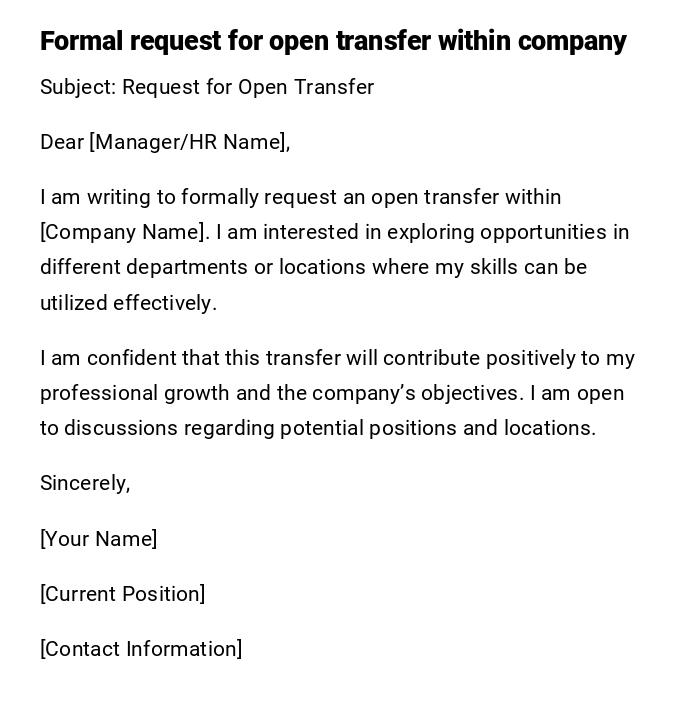
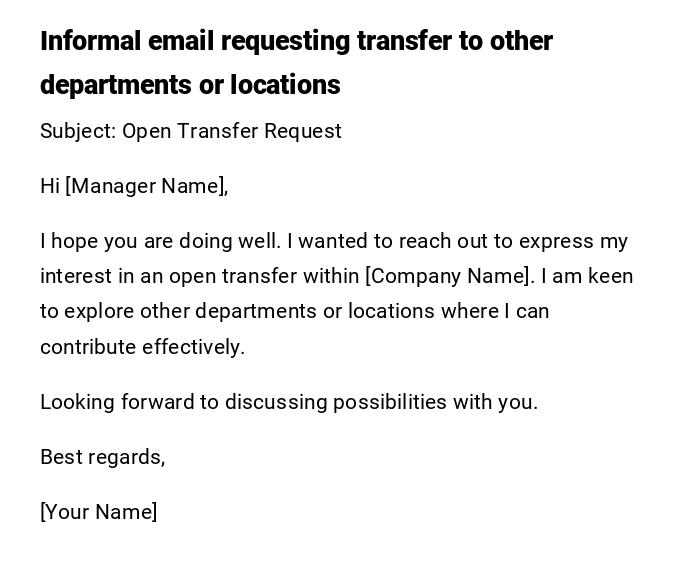
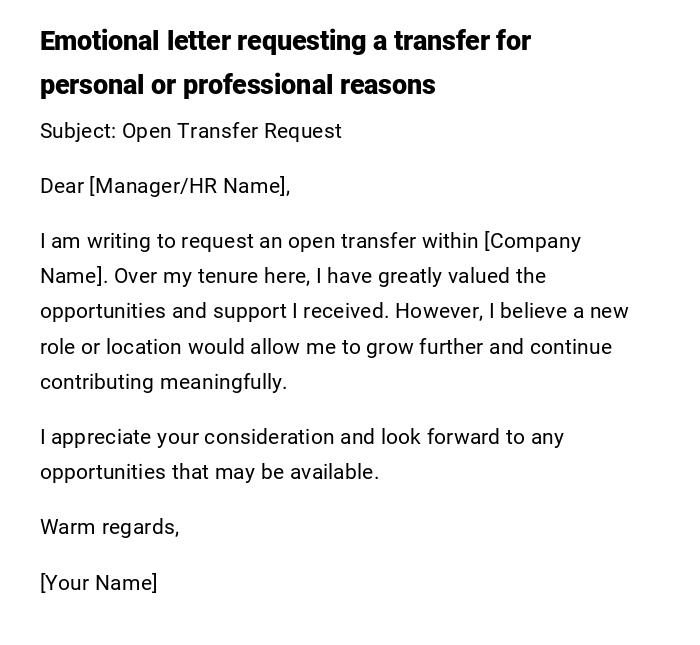
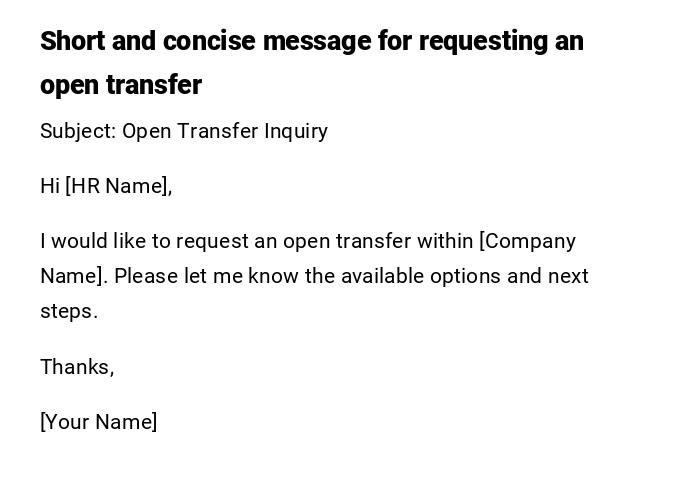
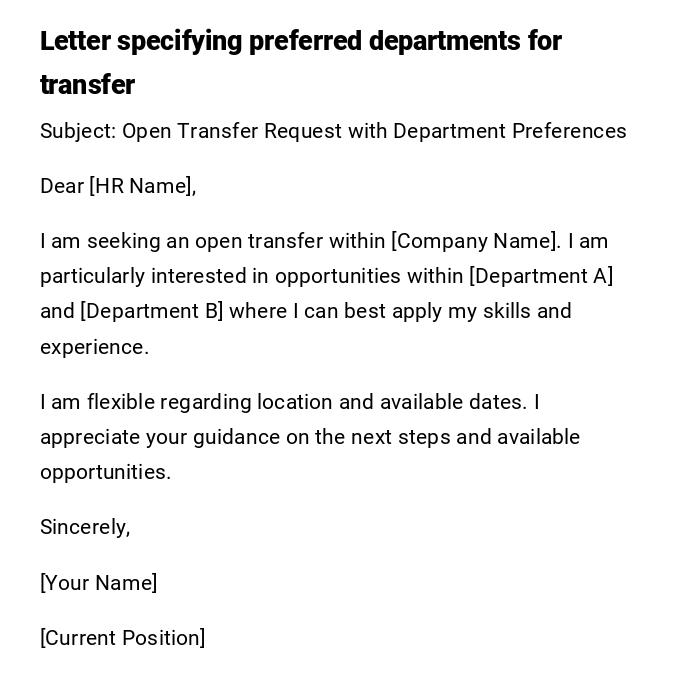

 Download Word Doc
Download Word Doc
 Download PDF
Download PDF